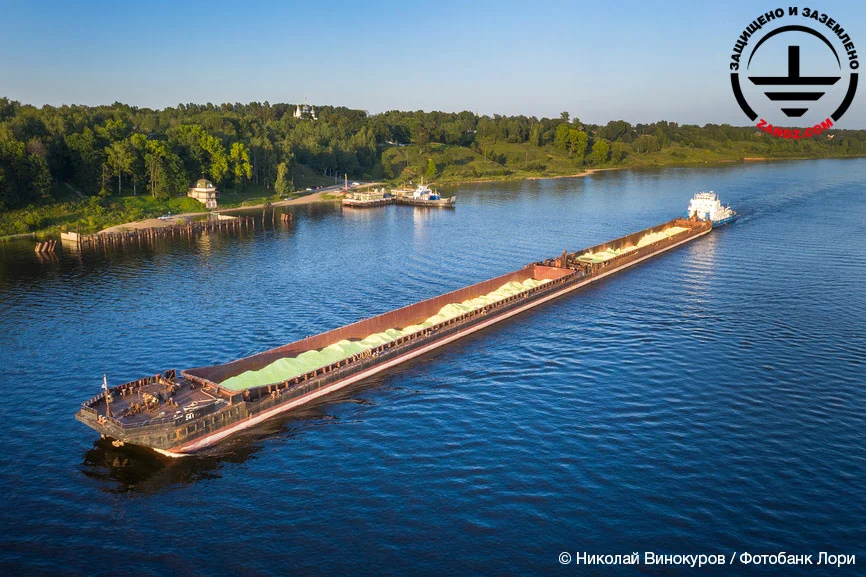The lightning protection for water transport is characterized by its specifics which justifies the use of additional regulatory documents. General lightning protection issues for river vessels are provided here, and for sea vessels, see here. This article is to consider lightning protection for one vessel type, namely barge. According to Sea Vessel Classification and Building Guidelines, a barge is a non-self-propelled cargo vessel intended for towage or push towing.
Regulatory documents
According to item 2.6.1.1 of Sea Vessel Classification and Building Guidelines, sea vessels should be equipped with lightning protection systems, and their protection zone should cover all equipment that requires lightning protection. Formally, it follows from this that, if a sea barge has no equipment on it that requires lightning protection, and the atmospheric electricity effect on the cargo cannot result in any catastrophic consequences, the lightning protection system may not be made. If secondary lightning effects may lead to fire or explosion, item 2.6.1.2 states that the vessel should have "lightning protection grounding means to avoid secondary sparking". It is a rather unclear phrasing although it says that if a barge carries dangerous cargo, the lightning protection is mandatory.

Sea Vessel Classification and Building Guidelines, item 13.1.1, clearly states that river non-self-propelled vessels (i.e. barges) may not have a lightning arrester system if they are intended to carry mineral cargoes (stones, gravel, etc.). Here, we can challenge the phrasing accuracy, since many mineral fertilizers are, e.g., dangerous in terms of ignition or even explosion. Nevertheless, item 13.1.1 requires that each river vessel would have a lightning protection for explosion and fire hazardous cargoes.
A list of cargoes that may be considered dangerous is approved by the Government of the Russian Federation. When this article was being written, a list provided in RF Government Regulation of March 10, 2022 No. 341 On Approval of a List of Cargoes of Increased Danger was effective.
Note that installation of GLONASS equipment for automatic tracking of barge movements is a current trend. Such equipment should be mandatory protected against lightning strikes. Thus, you cannot avoid lightning protection even if you only transport pit gravel. Another issue is that one of the lightning masts made of conductive material and having an electrical contact with the metal hull can serve as lightning protection with the effective radius covering GLONASS equipment only.
Lightning rod design
On vessels, usually metal lightning masts are used as lightning rods, which have an electric coupling with the vessel's metal hull. Electric coupling of such masts with the hull is typically provided at the barge construction stage. If masts are made of non-conductive materials, lightning rods are installed thereon and current collectors are made. Relatively low masts, i.e. several meters high, are usually installed at the barge. Generally, they may be insufficient to protect the cargo.
Considering significant length of the barge (65 to 114 m, on average), probably several lightning rods or wire lightning arresters are to be installed. Here we're talking about further equipping of the vessel. In existing regulatory documents, lightning rod design other than the one installed on the mast is not specified, therefore this task should be solved individually.
Grounding
Today's barges are usually made of metal. A vessel hull is used to ground the metal barge.
Another barge material that have revived interest of shipbuilders (especially due to the increase in liquefied natural gas carriage rates) is reinforced concrete. Theoretically, reinforced concrete structures can be used as natural grounding terminal by attaching the grounding wires to the metal reinforced bars. However, according to Reinforced Concrete Sea Vessel Hull and Floating Structures Building Guidelines, item 3.2.2, the reinforced bars should not directly contact water, and the protective concrete layer for outer body surfaces should be no less than 15 mm. Thus, the possibility to use reinforced concrete body for a vessel as a natural grounding terminal depends on the electrical conductivity of the concrete used. If it is insufficient, you will have to arrange grounding similarly to the one for the vessel having a composite hull according to item 2.6.4.1 of Sea Vessel Classification and Building Guidelines.
Conclusions
If you are not going to transport any other cargo than gravel, stones or similar, which are non-flammable and are not prone to explosion, you can only use lightning protection for the GLONASS equipment. Although, we still recommend using lightning protection for the entire barge. First, it allows carrying various cargoes, which is important in rapidly changing conditions on the market. Second, a list of dangerous goods is regularly revised, and the situation may appear when the cargo carried by a vessel company may be included into the list one day.
Recommendations for arranging lightning protection on barges does not contain the effective regulatory documents. At the same time, it is impossible to arrange lightning protection using masts available on the barge only, since the length of such vessel is 10 to 70 times the mast's height. Therefore, designs for each barge type will have to be developed separately.
Related Articles:

